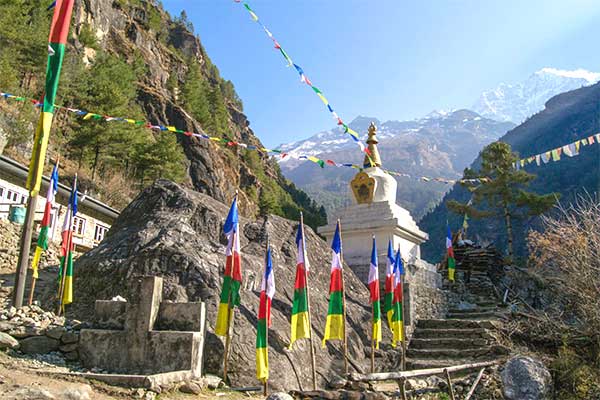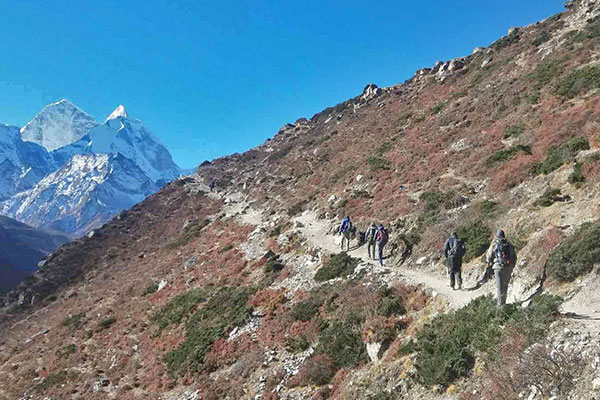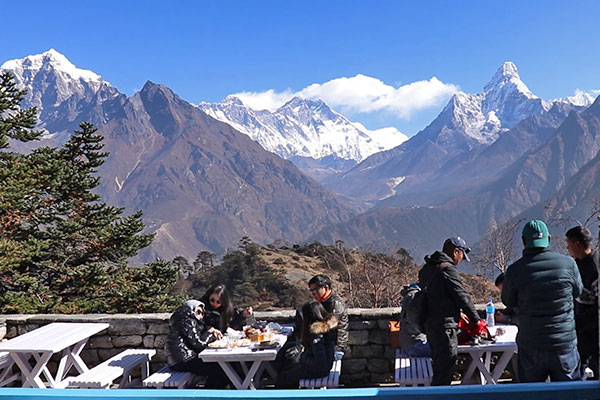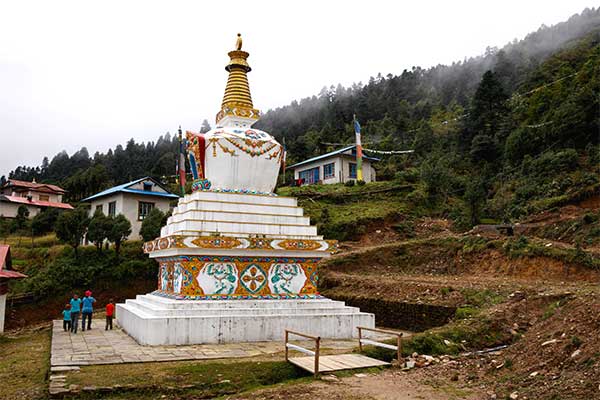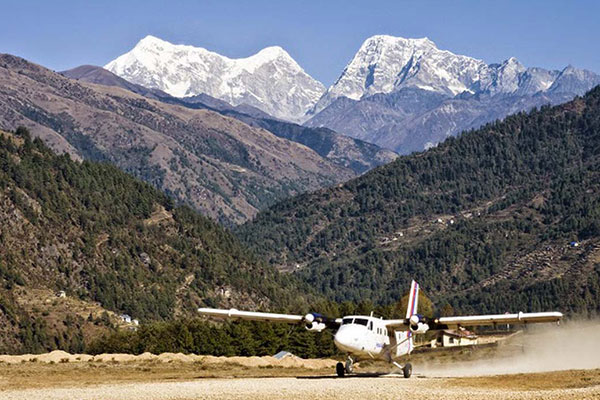Overview
Duration :
26 Days
Secondary Activity:
Nature and Special Culture
Max altitude :
3,350 m/10,990 ft
Transportation:
Private Vehicle
Trip ends in:
Kathmandu
Accomodation:
Lodge
Primary activity:
Trekking and Hiking
Group Size:
Min. 2 pax
Country:
Nepal
Trip starts from:
Kathmandu
Diffficulty:
Strenuous
Meals:
Nepali and Continental
Best Season:
Autumn and Spring
Trip route:
Kathmandu-Lamidanda-Halesi-Kharpa-Dumre-Harishe-Kurima-Chitre-Dimbul-Nirkum-Sorung-Bung-Khiraule-Sibuje-Kharikhola-Takshindu-Thupthen Chholing-Junbesi-Ngwar-Kilkurdding Gompa-Tolu Gompa-Patale-Rumjatar-Kathmandu
Trip introduction
Trekking the Monastery Circuit Trail in Nepal is an adventurous, exciting, and most insightful journey through the lower Solukhumbu districts of the Everest region. This monastery circuit trail offers us the opportunity to visit numerous architecturally beautiful and culturally rich monasteries. You also get to know the lifestyle of local inhabitants and interact with them. And passionately explore the monastery trail with great passion and enthusiasm.
Journey: Monastery Circuit Trail Trekking
Trekking the Monastery Circuit Trail begins as you arrive in Kathmandu. You will complete a city sightseeing tour around the heritage sites and get ready for the next day’s flight to Lami Danda. From Lami Danda, we will then drive to Halesi. Halesi Mahadev is both a Hindu and Buddhist pilgrimage site in the region. This temple is located at 1350m above sea level and has three caves representing the three eyes of Lord Shiva. Also, Buddhist followers worship these caves as Maratika monastery. Buddhism being the major religion among the local inhabitants, there are a number of monasteries built in the village.
Along with the Khumbu region, many ancient monasteries are carrying historical importance in lower-elevation districts. Like Okaldhunga and Khotang. Even though this region carries plenty of tourism potential; it has always been in the shadow of the more famous Everest region treks.
Therefore, TAAN(Trekking Agencies Association of Nepal), NTB (Nepal Tourism Board), and GHTP (Great Himalayan Trail Program) with support from the Ministry of Tourism and Civil Aviation, the new monastery trail in Nepal has been developed. During the final days of our trekking, we fly from Rumjatar to Kathmandu announcing the conclusion of this newly developed trek.
Health and Fitness Required for the Trek
Anyone with an average fitness level can join our insightful monastery circuit trail at any time of the year. There will be no acute mountain sickness or any other altitude problems on this trek. There are lots of cultural and religious exploring opportunities with great views of the highest Himalayas on the planet. Join Monastery Circuit Trail Trek with Nepal Mountain Trekkers now and contact us for booking and further information.
Special Note:
If this itinerary for Monastery Circuit Trail doesn’t suit your requirements or if you want to customize it, please feel free to contact us. This trek could be customized as per your required time frame and budget limits.
Overview
-
Day 1Arrive in Kathmandu:
-
Day 2Sightseeing Kathmandu valley and trek preparation:
-
Day 3Fly Kathmandu to Lamidanda (1,219m/4,000 ft) & Drive to Halesi (1,355m/4,444 ft):
-
Day 4Rest day at Halesi:
-
Day 5Halesi to Kharpa (1,221m/4,000 ft):
-
Day 6Kharpa to Dumre (1,300m/4,265 ft):
-
Day 7Dumre to Harishe (2,300m/7,545 ft):
-
Day 8Harishe to Kurima (2,400m/7,874 ft):
-
Day 9Kurima to Chitre (2,379m/7,805 ft):
-
Day 10Chitre to Dimbul (2,600m/8,530ft) via Dhodre:
-
Day 11Dimbul to Nirkum (2,913m/9,557 ft) and explore day:
-
Day 12Nirkum to Sorung (3,220m/10,564 ft):
-
Day 13Sorung to Bung (1,677m/5,500 ft):
-
Day 14Bung to Khiraule (2,693m/8,835 ft):
-
Day 15Khiraule to Sibuje (3,040m/9,973 ft):
-
Day 16Sibuje to Kharikhola (2,040m/6,692 ft):
-
Day 17Kharikhola to Takshindu (2,960m/9,711 ft):
-
Day 18Takshindu to Thupthen Chholing (2,920m/9,580 ft) via Ringmo:
-
Day 19Thupthen Chholing to Junbesi (2,700m/8,858 ft):
-
Day 20Junbesi to Ngwar (3,350m/10,990 ft):
-
Day 21Ngwar to Kilkurdding Gompa (3,098m/10,164 ft):
-
Day 22Kilkurdding Gompa to Tolu Gompa (3,020m/9,908 ft):
-
Day 23Tolu Gompa to Patale (2,840m/9,317 ft):
-
Day 24Patale to Rumjatar:
-
Day 25Fly Rumjatar to Kathmandu:
-
Day 26Departure Day:
Detail Itinerary
Day 1 : Arrive in Kathmandu::
As you arrive at Tribhuvan International Airport (TIA) and complete the customs formalities, you will be received by our representative holding the identity of our company. A representative of Nepal Mountain Trekkers will be there to welcome and transfer you to the hotel of your stay as you take a rest due to the tiredness resulting from a long flight. You may explore the areas surrounding the hotel of your stay or stay in the hotel itself. Enjoy the authentic Nepali cuisine and warm hospitality of the staff in the hotel of your stay. Stay overnight in Kathmandu.
Day 2 : Sightseeing Kathmandu valley and trek preparation::
A day to begin the exploration of this enchanting land begins with the exploration of the cultural and administrative capital city of Nepal, the medieval valley of Kathmandu. This enriching day shall mark the visit to the several heritages listed in the UNESCO World Heritage Site List. From the epitome of Hindu faith and one of the holiest temples in the world dedicated to the supreme Lord Shiva, the Pashupatinath Temple to the pilgrimage of Buddhists, the stupas of Boudhanath (one of the largest stupas in the world of its kind), and Swayambhunath (the 14th-century stupa, arguably the oldest stupa in the world) travelers have it all in terms of religious heritages and positive vibes radiated by these heritages. The other attraction is the symbol of excellence of Nepalese architecture and reflection of the golden age of Nepalese history, the Royal complex of Patan and the Patan Durbar Square. After exploration of these heritages, we shall also have interaction with the trekking guide for getting information required for the adventure. Stay overnight in Kathmandu.
Day 3 : Fly Kathmandu to Lamidanda (1,219m/4,000 ft) & Drive to Halesi (1,355m/4,444 ft)::
It is 142 km east from Kathmandu to Lamidanda. Kathmandu to Lamidanda flights is of 35 minutes. These are scheduled flights operated only by Tara Air and Nepal Air. We fly from Kathmandu to Lamidanda, and then start our trek to Halesi. It is about a 5-6 hours trek to reach Halesi Mahadev Temple. This is one of the famous Shiva temples in the east. There are many things to explore like caves, hills, and Maratika Monastery. Stay overnight at Halesi.
Day 4 : Rest day at Halesi::
Today you have a full day to explore and rest. You can explore the Halesi area which is believed that inside the temple, the Halesi Cave has been used as a dwelling for 6000 years. Lord Shiva hid there when hiding from the demon Bhasmasur. The location of this cave is between the holy rivers of Dudh Koshi and Sun Koshi. During Shivaratri, Rama Navami, and Ganesh Chaturthi fairs and festivities are held in the region. You can also explore Maratika cave which is 67 feet below the surface of the land and is both a revered religious place and a favorite tourist destination. Its entrance is shaped like a half-moon and faces towards the east. It has a round shape, with a diameter of 193 feet, with a separate cave lying beneath. The floor is 223 feet in circumference. Stay overnight at Halesi.
Day 5 : Halesi to Kharpa (1,221m/4,000 ft)::
The trek starts from the Halesi Mahadev temple area and passes through the beautiful villages of Arkhaule and Lamidanda. The scenic beauty around it is very much astonishing. Kharpa is a small village with few hotels and camping sites. Stay overnight at Kharpa.
Day 6 : Kharpa to Dumre (1,300m/4,265 ft)::
The trek from Kharpa after breakfast goes ahead to Rawa Khola at Armara and progresses along the river before crossing it at Bhaise. The trek then reaches Dumre Dharapani where accommodation is available on homestay to a beautiful monastery. Stay overnight at Dumre.
Day 7 : Dumre to Harishe (2,300m/7,545 ft)::
We meet the old Haleshi – Phaplu trekking route at Aishelu Kharka. Aishelu kharka is the old district headquarters of Khotang and the major trading center in the district. The hilly marketplace has hotels and lodges and other administrative departments. After having lunch at Aishelukharka, the trek passes through Deurali to reach Harishe for the nights stop. Stay overnight at Harishe.
Day 8 : Harishe to Kurima (2,400m/7,874 ft)::
Today after having our breakfast, we shall follow the trail to Kurima. We can visit the monastery at Diyale. The trail meets the GHT Sub Trail at Parma Ri that has a helipad. After reaching Kurima, we shall rest there for the night. Stay overnight at Kurima.
Day 9 : Kurima to Chitre (2,379m/7,805 ft)::
After spending the night at Kurima, the trek progresses through the GHT Sub Trail via Mude to reach Chitre for the night’s stop. Chitre is a small village with a helipad, few lodges, and two monasteries. It is a popular stopover for the trekkers on the GHT Sub Trail in Lower Solu. Stay overnight at Chitre.
Day 10 : Chitre to Dimbul (2,600m/8,530ft) via Dhodre::
The trek passes through the village of Dhodre to reach Dimbul. There is a monastery at Dhodre. Our trek from Chitre to Dimbul gives the scenic beauty of lower Solukhumbu and their cultural background. Stay overnight at Dimbul.
Day 11 : Dimbul to Nirkum (2,913m/9,557 ft) and explore day::
We begin our trek from Dimbul to Nirkum after our breakfast. After we reach Nirkum, we shall visit a monastery. This will really give us a great knowledge to distinguish the people living in different topography and the way they have been following their traditional norms and value. Stay overnight at Nirkum.
Day 12 : Nirkum to Sorung (3,220m/10,564 ft)::
Today we shall hike up to Sorung from Nirkum. After having our breakfast we shall trek from Nirkum to Sorung. During our hike today we shall see the best possible site around the village along with the monastery there which will help us to understand the people and their cultural activities. Stay overnight at Sorung.
Day 13 : Sorung to Bung (1,677m/5,500 ft)::
We, as usual, begin our trek after getting our breakfast from Sorung. Today we shall head onwards to a Rai village well known as Bung. The trail offers an amazing view of Lower Solukhumbu including the human influence that creates a vibrant atmosphere. There is a beautiful monastery too. Stay overnight at Bung.
Day 14 : Bung to Khiraule (2,693m/8,835 ft)::
The trek from Bung to Khiraule starts after having our breakfast. We find the little village very rich in vegetation especially the trees like rhododendron, Danfe, and meconopsis. Khiraule is at an elevation of 2,200 m and is surrounded by huge Himalayan Mountains and the deep gorge river running by the side of the village. There is a beautiful monastery at Khiraule. Stay overnight at Khiraule.
Day 15 : Khiraule to Sibuje (3,040m/9,973 ft)::
We trek to Sibuje passing through Phokte Kharka and Cherem Khola. We pass through Mani walls in the village which reflects human efforts in the course of civilization for a long. Sibuje is a remote farming community at an altitude of over 8,000 ft. near the border of the Everest Region and Makalu-Barun National Park. Sibuje is a remote mountain village, far from the tourist track of the Solukhumbu. The village is home to eighteen families, which is an average-sized Sherpa community. Most villagers are subsistence farmers, while a few works in tourism as guides and porters. Those who work in the tourism sector, during the spring and fall (high tourism season) come to Kathmandu to look for work. They return in early summer to help plant crops and reap the harvest. We can see the great Himalayan village life and Buddhist followers and their activities. Stay overnight at Sibuje.
Day 16 : Sibuje to Kharikhola (2,040m/6,692 ft)::
Today the trail that comes passing through Nirkum, Sibuje, Bung, Khiraule, and Cherem meets the popular Jiri- Everest trekking route at Kharikhola. The monastery at Kharikhola is worth visiting. Kharikhola is abuzz with foreigners during the peak season. Stay overnight at Kharikhola.
Day 17 : Kharikhola to Takshindu (2,960m/9,711 ft)::
We reach Takshindu after crossing the Dudh Koshi River on a suspension bridge. The trail is largely downhill and passes through Juving village. The trail offers magnificent views of Kusum Kangaru (6,367 m), Mt. Number (6,959 m), Khatang (6,853 m), and Karyalung (6,681 m). Takshindu gets its name from the beautiful Takshindu Monastery. This Sherpa village has a cheese factory. Stay overnight at Takshindu.
Day 18 : Takshindu to Thupthen Chholing (2,920m/9,580 ft) via Ringmo::
After breakfast, we shall start our trek from Takshindu and reach Thupthen Chholing Monastery through the beautiful Ringmo Village after crossing the Takshindu Pass (3,010 m). Ringmo is a beautiful Sherpa settlement with grass fields all around. The trail then passes through Junbesi village to the Thupthen Chholing Monastery. Stay overnight at Thupthen Chholing.
Day 19 : Thupthen Chholing to Junbesi (2,700m/8,858 ft)::
In the morning after breakfast, we climb down through the meadow for 20 minutes and cross over the suspension bridge. Then, the trail slowly ascends through the pine forest, heading to Salaung, which has a handful of homely teahouses. After lunch, we make a steep, draining climb down into the trees, looping in and out of the side valleys that are used for grazing by herders from Junbesi. Finally, we reach Junbesi Village after cross the wooden bridge. This sprawling village of large white houses with carved Tibetan-Style windows and overhanging eaves is set among scattered orchards above the Junbesi Khola. The lodges here make an excellent base for short treks to Tibetan Buddhist Monasteries in the surrounding valleys. Stay overnight at Junbesi.
Day 20 : Junbesi to Ngwar (3,350m/10,990 ft)::
The trek onwards shall mark the second phase of this adventure where we shall be returning from the marvelous, scenic, and ancient city of Junbesi. Further on trail is an overall downhill trek where we may take in one of two alternative trails as we reach the place of overnight for today, the village of Ngwar. Ngwar is a beautiful village where we will stay overnight and rest. Stay overnight at Ngwar.
Day 21 : Ngwar to Kilkurdding Gompa (3,098m/10,164 ft)::
Today we shall navigate through some beautiful villages, religious heritages, and warm hospitality of the locals. Further ahead, we climb uphill and explore the local area with the scenic surrounding. And as the day comes to an end, we move ahead and descend to the Kilkurdding Gompa, the destination of an overnight stay for today. Stay overnight at Kilkurdding Gompa.
Day 22 : Kilkurdding Gompa to Tolu Gompa (3,020m/9,908 ft)::
Today we head on to Tolu Gompa. As we wake up and after having our breakfast we shall head onwards to Tolu Gompa. Tolu Gompa is next to Patale and is located in the Sagarmatha Zone, the Eastern Region of Nepal. Tolu Gompa is our final destination for the day so here we will be staying overnight. Stay overnight at Tolu Gompa.
Day 23 : Tolu Gompa to Patale (2,840m/9,317 ft)::
After Tolu Gompa, we now move towards Patale. As the terrain declines, we now hike down from Tolu Gompa to our last destination of the day which is Patale. Patale is a fourth-order administrative division and is located in the Sagarmatha Zone, the Eastern Region of Nepal. The estimated terrain elevation of Patale is above sea level of 2840 meters. Stay overnight at Patale.
Day 24 : Patale to Rumjatar::
Today after having our breakfast we shall head on towards Rumjatar from where we will take a flight to Kathmandu tomorrow. Rumjatar is a market located in the Okhaldhunga district. Rumjatar is the largest and most well-known among the Gurung settlements of eastern Nepal. It sits atop a lone plateau overlooking the Roshi Khola and is regionally famous for both its beautifully hand-made Rhadi carpets and its seasonal orange crops. Stay overnight at Rumjatar.
Day 25 : Fly Rumjatar to Kathmandu::
Today is our last day of the trek. From Rumjatar today we shall take a flight back to Kathmandu. The flight takes about 35 minutes to reach Kathmandu and also there is only one flight per day so it is critical to be there on time. After reaching Kathmandu you can rest in your hotel rooms and then explore around Thamel area in the evening. Stay overnight at Kathmandu.
Day 26 : Departure Day::
Our exciting, adventurous, and rewarding trekking adventure comes to an end today. We hope that the memories of this trek tempt you to be back for further adventure and traveling experience in this Himalayan nation. A representative of Nepal Mountain Trekkers shall transfer you to the airport 3 hours before the flight schedule for your respective destination. We thank you for joining us for this wonderful trekking. Hope to see you soon in Nepal for some other adventurous or touristic activity.
Price Includes
- Airport Pickup and Drop
- 3 nights Hotel in Kathmandu (Hotel Green Horizon or similar standard)
- All accommodation during the trek in the best hotels/tea-houses in the area (differing according to the price you wish to spend)
- Sanitation: The accommodation we provide will be neat and clean with warm-hospitality and quality services.
- Single/Twin-sharing Accommodation (as per budget): Your group won’t have to share your accommodation with anyone else so your privacy is protected.
- All foods during the trek: Breakfast, Lunch, and Dinner; any items on the menu as much as you wish to consume.
- We provide hygienic and safe meals to re-energize you.
- You are not allowed to waste your meals because foods are quite expensive and difficult to cook and distribute in the Himalayas.
- You are not allowed to share your meals with anyone else.
- Domestic flights
- Professional and Highly experienced English-speaking Trekking Guide and Assistant Trekking (4 trekkers: 1 assistant guide) Guide licensed by the Government. Including their lodging and food.
- Local Staffs: Our guides are locals of the region which ensures that you will surely get to explore a bit more during the trek than with any other guides.
- Experienced: With an experience of more than a decade of working in this field, our trekking guides possess excellent knowledge on briefing during the trek as well as they are experts in handling all kinds of critical situations which might occur during the trek.
- Insurance: Nepal Mountain Trekkers have an insurance policy for all our trekking staff.
- Sherpa Porters (1 porter for 2 trekkers with a max load of 25 KG). Including their lodging and food.
- Local Staffs: The porters we hire belong to the same region where we trek in order to provide employment opportunities to the locals as well as to make you explore every prospect of the region.
- Four seasonal sleeping bags, down jacket, Nepal Mountain Trekkers duffer bag, t-shirt, and trekking map (Note: down jacket and sleeping bag are to be returned after trip completion)
- Trekking permits: TIMS card, Khumbu Pasang Lhamu Rural Municipality Tax, and Sagarmatha National Park fees
- A comprehensive medical kit
- 13 % VAT and 10% service charge
- Farewell dinner
Price Excludes
- Nepal Entry Visa fee (Visa Information)
- International airfare and excess baggage charges
- Food in Kathmandu
- Extra night accommodation and meal costs in Kathmandu due to any change in the scheduled itinerary
- Personal expenses (phone calls, laundry, bar bills, battery recharge, extra porters, bottle or boiled water, shower, etc)
- Travel insurance/ Rescue operation costs
- Tips for guides and porters
Trip Gallery
Trip Map:
Equipments
 Head
Head
- Sun hat or scarf
- Light balaclava or warm fleece hat
- Sunglasses
- Head Torch
- Suncreams(40+) and Lip Balms
 Upper Body
Upper Body
- Cotton t-shirts and thermals
- Fleece jacket
- Waterproof jacket
- Down jacket
 Lower Body
Lower Body
- Lightweight cotton pants (long)
- Waterproof pants
- Inner thermals
 Feet
Feet
- Thin inner socks (3 pairs)
- Thick, warm wool hiking socks
- Comfortable hiking boots
- Shower sandals
 Hands
Hands
- Gloves (Cotton and Waterproof)
- Creams
- Sanitizer
 Accessories
Accessories
- Sleeping bag rated to -10°C +
- Trekking bag (Rucksack)
- Duffel bag
- Large plastic bags (for keeping items dry inside trek bag)
- Trekking poles (optional, recommended)
- Water bottle or camel bag
- Toiletries and Tissue Papers
 First Aid Kits
First Aid Kits
- Personal Regular Medicines
- Knee Caps
- Bandages
- Ointments
- Blister Tape
Related Trips
You will also like …
